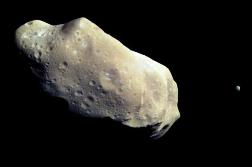
Ries is not alone
The Ries impactor was probably a chondritic stony meteorite, which interestingly might well have been accompanied in its final plunge by a small iron moon.
Ries is not the only crater in this part of SW Germany. It is widely believed that the 3.8 km Steinheim Basin impact structure formed at the same time. This crater is hosted by Triassic to Jurassic rocks, and samples of its suevite ejecta have recently yielded metallic spherules. Dr Elmar Buchner (University of Stuttgart) told the Meteoritical Society today that the presence of such spherules strongly indicated that Steinheim resulted from the impact of an “iron” meteorite.
Buchner believes there is a strong possibility that the Ries impactor, which would have been much larger, was actually one half of a binary pair, an asteroid with a small orbiting “moon” (comparable to the asteroid 243 Ida – picture). Clearwater Lakes, Canada, are also thought to have been created by such an impact of a binary asteroid.
This possibility, he said struck him as more likely than the alternative hypothesis – namely, that two meteorites should strike Bavaria independently at about the same time. Unfortunately, the date of the Steinheim impact is not as well constrained as that of Nördlinger-Ries, so currently two different dating methods are being used to rectify this deficiency. Results are expected later this year.